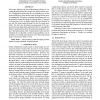Free Online Productivity Tools
i2Speak
i2Symbol
i2OCR
iTex2Img
iWeb2Print
iWeb2Shot
i2Type
iPdf2Split
iPdf2Merge
i2Bopomofo
i2Arabic
i2Style
i2Image
i2PDF
iLatex2Rtf
Sci2ools
110
Voted
ICIP
2008
IEEE
2008
IEEE
Hallucinating faces from thermal infrared images
This paper addresses the face hallucination problem of converting thermal infrared face images into photo-realistic ones. It is a challenging task because the two modalities are of dramatical difference, which makes many developed linear models inapplicable. We propose a learning-based framework synthesizing the normal face from the infrared input. Compared to the previous work, we further exploit the local linearity in not only the image spatial domain but also the image manifolds. We have also developed a measurement of the variance between an input and its prediction, thus we can apply the Markov random field model to the predicted normal face to improve the hallucination result. Experimental results show the advantage of our algorithm over the existing methods. Our algorithm can be readily generalized to solve other multi-modal image conversion problems as well.
Face Hallucination Problem | ICIP 2008 | Image Processing | Image Spatial Domain | Multi-modal Image Conversion | Normal Face | Thermal Infrared Face |
Related Content
| Added | 20 Oct 2009 |
| Updated | 20 Oct 2009 |
| Type | Conference |
| Year | 2008 |
| Where | ICIP |
| Authors | Jun Li, Pengwei Hao, Chao Zhang, Mingsong Dou |
Comments (0)

